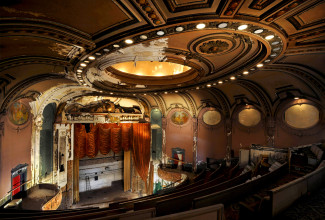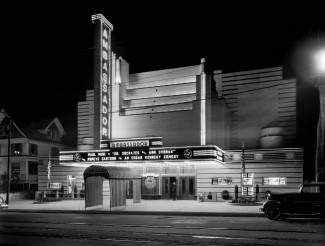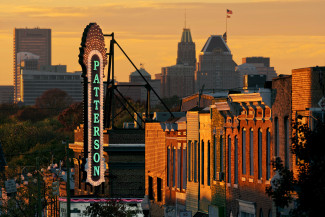
Johns Hopkins UniversityEst. 1876
America’s First Research University
Flickering Treasures: National Building Museum Exhibit Highlights Historic Baltimore Theaters

Flickering Treasures: Rediscovering Baltimore's Forgotten Movie Theaters by Amy Davis was published by Johns Hopkins University Press in 2017, and is currently the subject of an exhibition at the National Building Museum in Washington, D.C. Recently, Amy was interviewed by JHU Press staff member Will Holmes about the exhibit, which runs through December 2, 2019.
Your book Flickering Treasures: Rediscovering Baltimore's Forgotten Movie Theaters is a great fit for an exhibit at the National Building Museum. What sparked the idea for the exhibit, and how did it come to fruition?
I thought that Flickering Treasures would translate well as a museum exhibition, and considered several venues. I approached the National Building Museum in the fall of 2016 because their mission is to explore the history of architecture in a holistic way, by looking at the impact of the built environment on society and our personal lives. My book meshes well with these themes, by highlighting the eclectic architecture of movie theaters and issues of preservation. Flickering Treasures, through photographs and oral histories, examines how these buildings evolved, shaped their communities, and sparked the imagination of moviegoers through the power of film in a theatrical setting.
During our first meeting, I clicked immediately with NBM Curator Deborah Sorensen and the Vice President for Exhibitions and Collections, Cathy Frankel. We began working on the project the following year. Fortunately, once my book was in production at JHU Press by early 2017, I had more time to collaborate on the development of the exhibition as co-curator. The exhibition hews to my original proposal, but is more stunning than I could have imagined.
What should visitors to the exhibit expect to see? Are there any surprises for people who know and love your book?
The biggest surprise for me, and visitors, is the size! With the addition of many artifacts, the exhibition grew to about 4,000 sq. ft. At its core, the Flickering Treasures exhibition remains a showcase for my photography, but readers of the book might not realize that the galleries are filled with fascinating objects: architectural fragments, theater equipment, marvelous old seats and lighting, plus rare signage, programs and other ephemera. I had learned about many of these collectibles through my nine years of research and interviews. There is even a mini-theater, where visitors can experience the delights of a Saturday matinee with a cartoon, newsreel, serial and singing cowboys from the 1930s and 40s.

Image: The Parkway Theatre prior to its renovation, by Amy Davis.
How was the process of creating the exhibit different from the process of creating your book?
The museum exhibition was more of a collaborative process than creating the book. The book draws from many sources, but ultimately it is a very personal expression of my vision. The museum exhibition takes my perspective, and subtly recasts it as a case study of movie exhibition over the course of a century in one American city. Both the book and exhibition affectionately keep Baltimore as its focus, but the museum expands the topic in very informative ways so that one can understand the evolution of movie exhibition nationally.
I’m grateful to curator Deborah Sorensen for her deep knowledge of movies and film history, as well as her sensitivity during the selection process for photographs. The talented designers for the book, Maia Wright, and the exhibition, Rina Alfonso Osawa of Studio Aorta, both elevated the material while remaining true to my presentation wishes. The museum exhibition contains more creative interpretation and new material, by its very nature, than the book. We also had the opportunity to add new content for the exhibition. “The Avenue and Beyond” gallery, which looks at African-American movie theaters around Pennsylvania Avenue, features a new map by Robert Cronan of Lucidity Information Design that is not in the book. The exhibition afforded us more space to expand on themes such as segregation.
What do you think the impact of Flickering Treasures – both the book and the exhibit – has been? Is it what you hoped for? Were you surprised by it?
The biggest takeaway is that no matter where museum visitors come from, the immersive experience of Flickering Treasures is emotional. It triggers vivid personal cinematic memories, just as the book does. It’s been so popular that the exhibition has been extended from October – its original closing date – to February 17, 2020. I’ve gotten wonderful feedback during my personal visits, and reports from docents. One older woman in a tour group spied a movie title in one of the vintage photographs, and began singing a spirited rendition of the song from the movie! In the Afterword, I express my hope that the book “will spark a dialogue about how we can transform more of our forgotten theaters into catalysts for building thriving communities.” It is particularly gratifying to know that visitors to the National Building Museum from around the country, and abroad, may chance upon Flickering Treasures, and be enriched by it.

Earlier this year, the Pikes Theatre on Reisterstown Road reopened after a renovation, and recently, plans were announced to redevelop what remains of the Mayfair Theatre on Howard Street. What’s your reaction to these new developments since the publication of your book, and is there any other news related to historic Baltimore theaters that you would like to share?
I’d like to think that Flickering Treasures helped spark these efforts to reclaim shuttered theaters, but that is a stretch! There are larger economic forces at work in the recent uptick in redevelopment. In addition to the Mayfair on N. Howard Street, which only retains its façade, there are plans in the works to resuscitate a few other long-closed theaters. The Lord Baltimore and Capitol theaters, both on W. Baltimore Street, are slated to house community-based tenants that will strengthen their struggling neighborhoods.
An innovative non-profit based in Minneapolis, Artspace, has purchased the Art Deco Ambassador in northwest Baltimore, and will hold community meetings with stakeholders to determine how best to repurpose the long-vacant theater for the arts. At the busy intersection of Pennsylvania and North Avenues, the 1912 Schanze theater, now the home of the Arch Social Club, is a key component in the newly designated Pennsylvania Avenue Arts and Entertainment District. Plans are in the works to turn the former Ideal in Hampden, most recently a dance studio, into an intimate, upscale concert venue.
The Boulevard in Waverly, underutilized as a discount retail outlet, is now owned by Johns Hopkins University. I eagerly await word on their vision for this once-beautiful neighborhood theater. Hopkins, which was instrumental in the revival of the Parkway theater at North Avenue and Charles Street, houses its film program in the former Centre theater across the street. Nearby, the former Playhouse at 9 W. 25th Street, a popular art house theater in the 1950s, is now the headquarters of Figure 53, a software company that has plans to add an experimental black box theater. Look for a creative makeover of the façade, to reflect their performing arts-related work, in the coming year.
On the east side, the former Belnord theater on Pulaski Highway is being renovated by CASA de Maryland as an employment center for immigrant and minority city residents. I post news and history about all of the city’s theaters on my public Facebook page, www.facebook.com/flickeringtreasures. For any developers reading this, there are at least a half-dozen other Baltimore theaters, owned by churches, but abandoned because of the daunting upkeep, that need to be rescued. Some are in dire shape. I have always marveled that of the 72 theaters in the book, only 11 have been completely razed. So, with Flickering Treasures as inspiration, look around – you may find one that is ready for a new life!

What can people who care about Baltimore’s historic movie theaters do to help preserve these ‘flickering treasures’?
Short of rescuing one of our endangered theaters, such as the Apollo, Bridge, Harlem, Irvington, Lenox and Ritz, all of our historic buildings, from humble rowhouses to larger structures, need our advocacy. We can all recall too many buildings, not just movie palaces, which have been torn down, propelled by greed and shortsighted policies. Baltimoreans can support the programs at Creative Alliance on Eastern Avenue, which has proved how a theater can be repurposed for the benefit of its community.
My simplest recommendation, however, is to go to a movie theater. Turn off your phone and laptop, and experience film in a communal setting. The Parkway, home to the Maryland Film Festival, and pictured on the cover of Flickering Treasures, is a truly unique place to enjoy a movie. As a “rescued ruin,” the layers of decay, artfully preserved inside the elegant 1915 theater, are poignant reminders of what happens to our flickering treasures when we abandon them.
Amy Davis has worked as a staff photographer at The Baltimore Sun since 1987. She is the author of Flickering Treasures: Rediscovering Baltimore's Forgotten Movie Theaters. Visit the book's website at www.flickeringtreasures.com
National Building Museum exhibition: www.nbm.org/exhibition/flickering-treasures/
Like Flickering Treasures on Facebook: www.facebook.com/flickeringtreasures
Flickering Treasures events and book signings are posted on the Flickering Treasures website and public Facebook page.
Upcoming Events:
The Flickering Treasures Film Series at AFI Silver Theatre and Cultural Center concludes on Saturday, Aug. 24, with a screening of Matinee, featuring John Goodman, at 4:45 PM. Amy Davis will be signing books after the film. This summer series is presented in partnership with the National Building Museum. https://silver.afi.com/Browsing/Movies/Details/f-0100002573
National Building Museum offsite walking tour with Amy Davis: Historic Theaters of Downtown Baltimore, Sept. 14, 10:00 AM – 12:00 PM. $25, pre-registration required. http://go.nbm.org/site/Calendar/1814244456?view=Detail&id=125650


